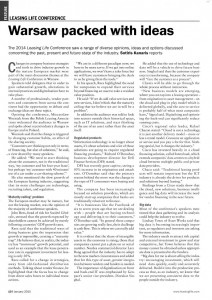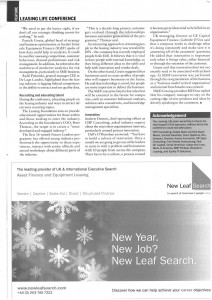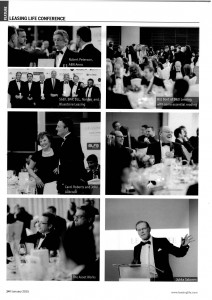The 2014 Leasing Life Conference saw a range of diverse opinions, ideas and options discussed concerning the past, present and future state of the industry. Sotiris Kanaris reports
Changes in company business strategies and tools to drive industry growth in the mature European market were part of the main discussion themes at the Leasing Life Conference in Warsaw.
Speakers told delegates that in order to gain substantial growth, alterations in internal practices and digitalisation have to take place.
A number of professionals, vendor partners and customers from across the continent had the opportunity to debate and exchange ideas on these topics.
Opening the conference, Mieczyslaw Wozniak from the Polish Leasing Associations welcomed the audience to Warsaw and spoke about recent industry changes in Europe and in Poland.
Wozniak said that the change is triggered by changing customer habits, an effect of the sharing society.
“Customers are thinking not only in terms of financing, but also of solutions,” he said, a view shared by many speakers.
He added: “We need to start thinking about the consumer, not in the traditional way, ‘my customer and his four-year lease’, but perhaps ‘my customer with 40 minutes’ use of a car under a car-sharing scheme’.”
He also mentioned the slow growth of the European leasing industry, suggesting that its main challenges are technology, recruiting talent, and regulation.
‘Maturity ceiling’ problem
The European market may be mature, but not the leasing market, was the opinion of the majority of conference speakers.
John Rees, head of risk for Societe Generale, stressed that the growth expected by shareholders cannot be achieved by merely following countries’ GDP growth rates.
Rees said that the traditional ways of doing business give the impression that growth is impossible, creating a “maturity trap”. He believes that, in reality, the industry has “enormous” growth potential, and used as an example that the lease penetration rate in equipment investment for leasing is only 30%.
Rees called for a change in strategies, away from old -fashioned distribution methods. Talking about vendor finance, he highlighted that the focus has to change from direct sales forces to individual transactions.
“We are in a different paradigm now; we have to be more savvy. If we get into online applications, we won’t have a sales force but we will have customers bringing the deals to us by giving them the tools.”
In his speech, Rees highlighted the need for companies to expand their services beyond financing an asset to take a residual value position.
He said: “If we do add value services and new services, I don’t think that the maturity ceiling that we believe we are in will be a problem”.
In addition the audience was told to look into sectors outside their historical space, such as IT solutions, and start thinking of the use of an asset rather than the asset itself.
Regulated products
“Information technology is no longer about assets, it’s about solutions and a lot of those solutions are going to require regulated financing products,” Richard O’Donohue, business development director for Dell Finance Services (DFS) stated.
DFS has recently gone captive, seeing a 50% increase in its origination and attach rate. O’Donohue said that the primary reason behind the move was the change in the type of IT consumers were buying and using.
The company has been increasingly focused on solution providers, which are mostly start-up companies that banks are traditionally reluctant to finance.
“It is businesses like the Facebook of six to seven years ago that we are dealing with – people that are buying technology and delivering it to their customers,” O’Donohue said. “In general these companies are growing really fast, their challenge is cash flow. This is where we can really add value.”
It is evident that the share of intangible assets in the economy is rising; those that companies cannot put a plate on or serial number. Nordea commercial director Lars Bang agreed that the industry has to adapt to the new market circumstances and added that for this type of asset, greater integration between vendors and funders is needed.
The importance of digitalisation on front and back-end IT was emphasised by Genpact’s senior vice-president, Diwakar Singhal.
He added that the use of technology and data will be a vehicle to drive future business. Singhal said that the customer experience is transforming, because the company will “face the customer as a process”.
Clients will be able to go through the whole process without interaction.
“New business models are emerging, where you can tap into a leasing operation – from origination to asset management – on the cloud and plug-in play model which is delivered globally, and the cost to service is probably half of what most companies have,” Signal said. Digitalising and optimising the back-end can significantly reduce running costs.
Cisco’s regional sales leader, Rafael Chacon stated: “Cloud is not a technology, it is just another delivery model – more or less a rental model. Consume an application or service and you pay a fee for that. Nothing special, but it changes the industry.”
Cisco has invested heavily in a c loud financing solution, called lntercloud, which extends companies’ data centres to a hybrid cloud between multiple public and private data providers.
Chaco said: “Traditional leasing products will remain important but the ICT industry is already the driver for products and solutions beyond leasing.”
Findings from a Cisco study show that the cloud, new solutions, business intelligence and big data will increase the need for vendor financing in the near future.
Big data
Most of the conference’s speakers mentioned that data gathering and its analysis could help the industry to evolve.
Lindsay Town of Asset Works said that big data is becoming increasingly important, as regulators and investors are asking for more information.
The industry needs to attract risk capital and external investment to grow and stay competitive, but Town believes that this money cannot be obtained unless appropriate data is presented to the funders.
“Big data for me is about selling the industry: encouraging investment, which will need data quickly, easily and accurately delivered. Build it into the production process so that, as an industry, we know that we are presenting consistent data to the people outside the industry.
“We need to get the basics right, if we don’t all our strategic thinking counts for nothing,”‘ he said.
Patrick Gouin, global head of strategy and business optimisation at Societe Generale Equipment Finance (SGEF) spoke of how data could help in analytics. It could be used for assessing competition, customer behaviour, channel performance and risk management. In addition, he referred to the usefulness of predictive analytics for risk management, particularly in SME business.
Rafal Piskorski, general manager CEE at De Lage Landen, highlighted chat the leasing industry is lagging behind competitors in the ability to extract and use quality data.
Recruiting and educating talent
During the conference, educating people on the leasing industry and ways to attract talent were recurring topics.
The Leasing Foundation aims to provide educational opportunities for those within and those wishing to enter the industry. According to the foundation ‘s COO, Peter Thomas, the target is to create a “more developed and engaged industry”.
The first 16-month Future Leaders programme has offered young industry professionals the opportunity to share experiences, interact with senior officials and attend workshops about different parts of the industry.
“This is a decade-long project; outcome gets realised through the relationships between successive generations of the programme,” Thomas said.
An interesting approach to attracting people to the leasing industry was revealed by DFS – the company has recently employed people from Dell. It believes that it is vital to have people with external knowledge, as they bring different ideas to the table and help with innovation and vendor deals.
On the other hand, Gouin suggested that businesses need to create profiles of people who will support businesses in the future. He said that technology is a tool, but people are more important to deliver the business.
The SGEF executive listed a few roles that will be essential in the future for companies, such as customer behaviour analysts, solution sales consultants, and knowledge management specialists.
Innovation
Andrew Denton, chief operating officer at CHP Consulting, asked industry experts about the ways their organisations innovate, particularly around process innovation.
Dell’s O’Donohue answered: “You have to build a culture of innovation. Once a month we are going to get one of the leaders to come in with a problem and brainstorm with 10 people from across the company. There has to be a culture, a process around it because great ideas tend to be killed in an organisation .”
UK managing director at GE Capital Equipment Finance, Gabriele D’Uva said that a company needs to challenge what it’s doing constantly and make sure it is answering all of the customers’ questions. He added that innovation is important only when it brings value, either financial or through the retention of the customer.
Gouin said that innovation does not necessarily need to be associated with technology. At SGEF innovation was performed through the resegmentation of the business, as a “business model vertical organisation’ and internal benchmarks was created.
D&D Leasing president Bill Dost replied that his company manages to stay on the cutting edge of new products and ideas by directly speaking to the customers.





